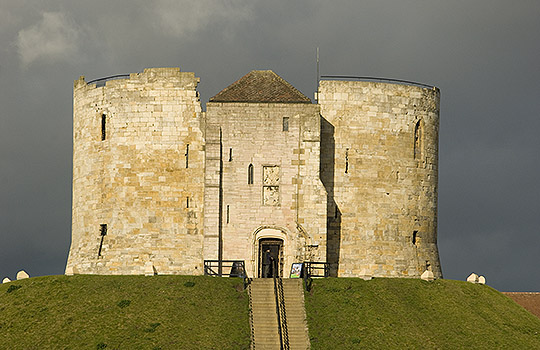Research on Clifford’s Tower
Clifford's Tower has been much discussed in the context of the development of English castles. The motte has great archaeological potential.

Documentary and Historical Research
Because of its architectural oddity, Clifford's Tower is mentioned in a number of antiquarian accounts and in general histories of the development of English castles.[1]
The documentary history of the castle in the Middle Ages is set out in the first two volumes of The History of the King's Works.[2] One of the authors of these volumes, Arnold Taylor, published an article in 1955 demonstrating that Clifford's Tower dates to the mid-13th century.[3]
In 1972 the Royal Commission on the Historical Monuments of England gave a detailed account of the tower and the wider castle in all periods in a dedicated publication on the defences of York.[4] Barrie Dobson's discussion of the 1190 massacre of the Jews, first published in 1974, remains the indispensable source for understanding this event.[5]
Archaeological Investigations
It is overwhelmingly likely that the earth motte was formed through historical addition since the 11th century, retaining material from the early castles in its interior. Very little investigation has ever been carried out into it and the principal source of information is a short article summarising the observations made in 1902 during Basil Mott's works to underpin the south-east lobe.[6]
In the early 21st century, a number of studies were carried out during a revision of the Conservation Plan[7] and as enabling studies for the possible addition (not yet taken further) of a new structure inside the ruined monument. Research included a reappraisal of contemporary documentation for the tower's internal layout in the Middle Ages, a non-invasive archaeological analysis of the standing structure and a ground-penetrating radar survey of the north-east lobe.
These studies were in general suggestive rather than conclusive for the medieval development of the tower, and indicated that the 17th-century refortification might offer greater scope for understanding.
Future Research
The form and history of the monument mean that high cost and sensitivity will be involved in any archaeological excavation of Clifford's Tower. A number of pressing topics for archaeological research remain, however, including:
- evidence for occupation of the site before the foundation of the first castle in 1068
- the survival and nature of evidence for earlier phases of the castle, including the castles of the 11th century, the buildings damaged or destroyed in 1190 and a possible phase in the 1220s
- structures preserved within the motte indicating the internal configuration of Clifford's Tower in the Middle Ages and subsequently, including the refortification of the tower in the 17th century.
Medieval works accounts contain a number of points suggesting that the medieval tower had a complicated internal layout. It is described as a number of 'buildings/houses', with separate lead-covered roofs. These documents continue to offer much scope for reappraisal (see Sources for Clifford's Tower).
READ MORE ABOUT CLIFFORD'S TOWER
Footnotes
1. GT Clark, 'The defences of York', Yorkshire Archaeological Journal, 4 (1877), 1–42, esp 36–7 (accessed 29 October 2014).
2. RA Brown, HM Colvin and AJ Taylor, The History of the King's Works, vol 2: The Middle Ages (London, 1963), 889–94.
3. AJ Taylor, 'The date of Clifford's Tower, York', Archaeological Journal, 111 (1954), 153–9 (accessed 29 October 2014).
4. Royal Commission on the Historical Monuments of England, Inventory of the Historical Monuments in the City of York, vol 2: The Defences (London, 1972) (accessed 29 October 2014).
5. RB Dobson, The Jews of Medieval York and the Massacre of 1190 (York, 1974; rev edn 1996).
6. G Benson and H Platnauer, 'Notes on Clifford's Tower', Yorkshire Philosophical Society Report for 1902 (1903), 68–74.
7. Field Archaeology Specialists, 'Clifford's Tower conservation plan', unpublished report (2006).
